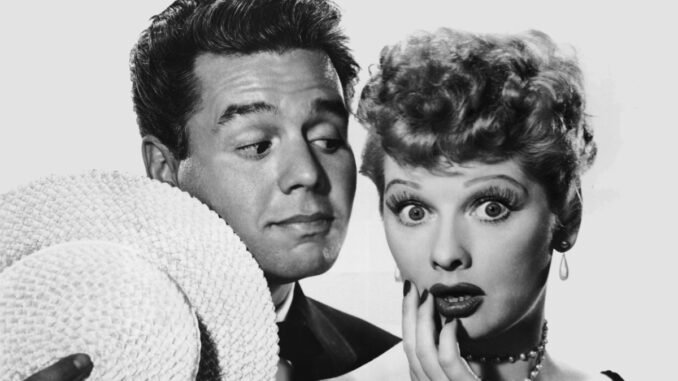
At a time when television was in its infancy, when four networks (ABC, CBS, NBC and the long defunct DuMont) were trying to find their way, along came the universally beloved I Love Lucy on CBS on this day in 1951. Seven decades later and nothing else still compares to the comedic antics of Lucille Ball and Desi Arnaz as Lucy and Ricky Ricardo, and the ultimate “second bananas”: Vivian Vance and William Frawley as Ethel and Fred Mertz.
Minus competition from cable and digital, I Love Lucy was an immediate sensation, finishing the first of its six seasons as the third highest rated program in all of primetime (behind Arthur Godfrey’s Talent Scouts, which it immediately followed on Monday nights, and Texaco Star Theater with Milton Berle). The situations were relatable, as the middle class Ricardos experienced the typical trials and tribulations of married life. The humor came from the ordinary situations often exaggerated by Lucy’s ability to get herself into trouble and then proceed to untangle herself from the situation. And the end result were four characters who, 70 years later, we still enjoy spending time with.
Known as the first TV sitcom to be filmed with three cameras on 35-mm film in front of a live audience, I Love Lucy defined the genre. It introduced the off-network syndication formula, recognizing the value of episode repeats. And, at a time when diversity on screen was reduced to seeing any rare character of color in a subservient capacity, I Love Lucy was the first television series to feature an interracial couple. Desi Arnaz, of course, was of Cuban descent (which was an initial concern by CBS).
By season two, I Love Lucy inherited the top spot in all of primetime, never ranking below No. 3 overall for any of its six seasons and ending its run as the most-watched series on television. Only two other shows (both sitcoms) accomplished that feat: CBS’ The Andy Griffith Show and NBC’s Seinfeld. But I Love Lucy was also not without some controversy and some misconceptions.
The censors did not allow the writers to use the word “pregnant” when Lucy’s pregnancy in real life resulted in the same situation for Lucy Ricardo in season two. “Expecting” was the agreed upon phrase. And I Love Lucy was not the first TV series to feature a TV pregnancy as commonly believed. That honor goes to Mary Kay and Johnny, which featured real-life married couple Mary Kay and Johnny Stearns. It aired prior to I Love Lucy, from 1947 to 1950.
Scores of articles and books have been published summarizing the value, the importance, the legacy, and the just plain fun of I Love Lucy. How many times, after all, have you seen such memorable episodes as “Lucy Does a TV Commercial,” “Job Switching,” L.A. at Last,” “Lucy’s Italian Movie” and the countless others?
To reiterate some of the documented highlights, here are six factoids that you may (or may not) already know.
1) Dwight D. Eishenhower’s presidential inauguration drew 29 million viewers on January 20, 1953. The next day, 44 million viewers tuned in to watch Lucy give birth to little Ricky, which accounted for 72% of all TV homes at the time. In real life, Lucy gave birth to Desi Arnaz, Jr. on the same day Little Ricky was born.
2) Bea Benaderet was the first choice to play Ethel Mertz, but was unavailable due to her role as Blanche Morton on The George Burns and Gracie Allen Show. Benaderet, however, guest-starred in the season one episode “Lucy Plays Cupid.”
3) Barbara Pepper, who is remembered as Doris Ziffel on zany sitcom on Green Acres, was also considered to play Ethel. Pepper in real life was Lucy’s personal friend, and she ultimately appeared in 10 episodes of I Love Lucy (including season one’s “Breaking the Lease”).
4) Lucy’s eventual sidekick, Gale Gordon, was the first choice to play Fred Mertz, but was contacted to sitcom Our Miss Brooks with Eve Arden. Gordon, however, appeared twice as Ricky Ricardo’s boss, Alvin Littlefield, owner of the Tropicana Club where Ricky’s band played, and later as a judge on an episode of The Lucy-Desi Comedy Hour. Arden, meanwhile, had a cameo appearance as herself in the “L.A. at Last” episode of I Love Lucy with William Holden.
5) Despite an age different of 22 years, William Frawley as Fred on camera with TV wife Ethel seemed like the perfect fit. But legend has it the two were far from fond of each other. Talks of a potential spin-off featuring the pair after I Love Lucy concluded were immediately nixed by Vance. Had it moved forward, it would have been the first spin-off series in the history of television.
